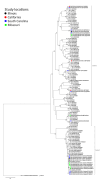Molecular Characterization of Noroviruses Causing Acute Gastroenteritis Outbreaks among US Military Recruits, 2013-2023
- PMID: 39530888
- PMCID: PMC11559571
- DOI: 10.3201/eid3014.240307
Molecular Characterization of Noroviruses Causing Acute Gastroenteritis Outbreaks among US Military Recruits, 2013-2023
Abstract
Norovirus is the leading cause of acute gastroenteritis (AGE) worldwide. Norovirus outbreaks at military facilities can cause loss of training and working days and increased healthcare utilization, affecting force readiness. During 2013-2023, we enrolled 2,304 US military recruits from 4 basic training facilities to investigate AGE outbreaks among this population. Among enrollees, we detected norovirus in 433 (18.8%) AGE cases, and norovirus caused 49 AGE outbreaks during our longitudinal study. On average, each norovirus case-patient missed 1.2 training days due to illness, and 6.2% required infusion care. Whole-genome sequencing of selected samples from each outbreak produced full-length genomes (6,989-7,787 bp) for 39 samples. Norovirus GII.4 Sydney was the most (12/39, 30.8%) identified genotype over the study period. Phylogenetic and comparative genomic analyses revealed that several outbreak strains were responsible for causing >1 outbreak, even across different training sites. Our findings can inform infection control practices at military installations and overall norovirus vaccine development.
Keywords: AGE; Norovirus; US military; United States; WGS; acute gastroenteritis; enteric infections; recruit training; viruses; whole-genome sequencing.
Figures



References
Publication types
MeSH terms
LinkOut - more resources
Full Text Sources
Medical

